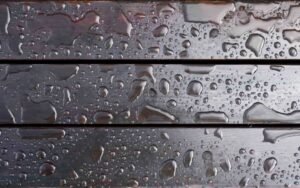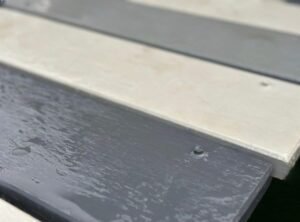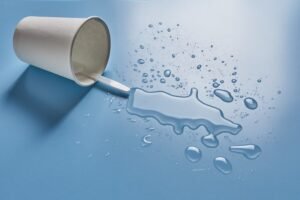Introduction to Waterproof Wall Paint
Waterproof wall paint is a specialized type of coating designed to prevent water penetration and protect surfaces from moisture damage. Unlike regular paint, which primarily focuses on aesthetics and may not necessarily guard against water, waterproof paint incorporates advanced formulations that create a barrier against moisture. This makes it an essential choice for areas prone to dampness, such as basements, bathrooms, and kitchens, where traditional paint products may fail over time.
The primary purpose of waterproof wall paint is to ensure that walls remain dry and free from mold and mildew growth, which can compromise both the structural integrity of a building and the health of its occupants. By using waterproof paint, property owners can prolong the lifespan of their walls while also maintaining a clean and visually appealing environment. The benefits are particularly pronounced in environments that experience high humidity or frequent water exposure, where moisture can lead to peeling paint and unsightly stains.
In comparison to conventional wall paint, waterproof options often contain additives such as sealants and fungicides. These ingredients enhance the paint’s resistance to water and prevent the growth of harmful microorganisms, making it a superior choice for protection against moisture-related issues. Additionally, waterproof wall paint is available in a variety of colors and finishes, allowing for both functional and aesthetic improvements in living spaces.
Whether for residential or commercial use, understanding the importance of waterproof wall paint is crucial for anyone looking to protect their property from water damage. In regions or buildings that experience significant moisture, the application of waterproof coatings not only maintains structural integrity but also contributes to a healthier indoor environment.

Types of Waterproof Wall Paint
When it comes to choosing waterproof wall paint for your home or commercial space, there are several types available, each offering unique properties and benefits. The primary options include latex-based, oil-based, and specialty paints such as elastomeric coatings.
Latex-based waterproof paints are among the most popular choices due to their ease of use, quick drying times, and low levels of volatile organic compounds (VOCs). These paints are water-soluble and can be easily cleaned up with soap and water. Ideal for interior and exterior applications, latex paints provide decent durability and flexibility, allowing them to expand and contract with temperature changes. However, while they resist mildew and mold effectively, they may not be suitable for very high moisture areas without proper preparation.
Oil-based waterproof wall paints offer superior durability and a high-gloss finish, making them an excellent option for regions exposed to harsh elements. Their thicker consistency creates a formidable barrier against moisture, making them suitable for areas prone to water infiltration. Despite their advantages, oil-based paints have longer drying times and require solvents for cleanup, which increases application complexity and reduces user-friendliness.
Specialty waterproof paints, such as elastomeric coatings, stand out due to their advanced elasticity. These paints can bridge hairline cracks in walls while providing a strong water-resistant membrane. Elastomeric coatings are directed toward exterior surfaces and are particularly effective in areas subjected to water ponds. Although they are more expensive than standard options and may require professional application, their longevity and performance under challenging conditions can justify the investment.
Each type of waterproof wall paint presents distinct advantages and disadvantages. Understanding these differences will enable homeowners and professionals to make informed decisions based on the specific requirements of their projects, ultimately ensuring the selected paint achieves both aesthetic and functional goals.


Key Features to Consider When Choosing Waterproof Wall Paint
When selecting waterproof wall paint, several critical features warrant consideration to ensure optimal performance in moisture-laden environments. The primary attribute to assess is moisture resistance. High-quality waterproof paints are designed to repel water, preventing penetration and subsequent damage to the underlying structure. This characteristic is essential, particularly in areas prone to high humidity, such as bathrooms and basements.
Another significant feature is mold and mildew prevention. Due to the damp nature of environments where waterproof paint is typically applied, choosing a product that inhibits the growth of mold and mildew is crucial for maintaining hygiene and enhancing air quality. Paints specifically formulated with antimicrobial properties can effectively reduce the likelihood of growth, which is a considerable advantage for those concerned about health implications.
Durability is also a vital factor. Waterproof wall paint should withstand wear and tear while resisting peeling, cracking, and fading over time. Selecting a product that comes with a guarantee or warranty can provide additional peace of mind regarding its long-lasting performance. Additionally, ease of application should not be overlooked; user-friendly paints save time and effort during the painting process, contributing to a smoother experience.
Drying time is another important consideration, particularly for those looking to minimize downtime in their living spaces. Some waterproof paints offer fast drying capabilities, allowing projects to be completed swiftly without compromising on quality. Lastly, choosing paints with low volatile organic compounds (VOCs) is essential not just for health reasons, as these compounds can have adverse effects on indoor air quality, but also for environmental sustainability. Selecting a product that balances performance with environmental considerations is crucial for responsible decorating.

Top Brands of Waterproof Wall Paint
When it comes to selecting waterproof wall paint, several brands stand out for their quality, durability, and overall customer satisfaction. Leading the pack are Behr, Sherwin-Williams, and Benjamin Moore, all of which offer a variety of options to cater to different needs and preferences.
Behr is well-known for its extensive range of waterproof paints that guarantee protection against moisture without compromising on style. Their Premium Plus line features exceptional water resistance, making it a popular choice for interiors exposed to humidity, such as bathrooms and kitchens. Users frequently praise Behr for ease of application and impressive coverage, which solidifies its reputation within the market.
Sherwin-Williams is another leading brand that produces high-quality waterproof wall paint, specifically their Duration and SuperPaint lines. These products have been designed to withstand the test of time while preventing mold and mildew growth. With a vast array of colors and finishes available, Sherwin-Williams appeals to both professionals and DIY enthusiasts alike. Customers commend the brand for its service and expert guidance, which adds further value to their offerings.
Lastly, Benjamin Moore is synonymous with premium quality, offering waterproof paints that deliver both aesthetic appeal and functional resilience. Their Regal Select line is highly regarded for its exceptional coverage and washability, allowing consumers to maintain a fresh look even in high-moisture environments. The brand enjoys a loyal customer base who consistently highlight its reputation for innovation and sustainability in paints.
In summary, these top brands of waterproof wall paint provide various options suited for multiple applications, ensuring that consumers can find products designed to protect their spaces from the damaging effects of moisture while maintaining a stylish appearance.

Preparation and Application Process
Applying waterproof wall paint effectively starts with thorough preparation. To ensure optimal adhesion and long-lasting results, it is essential to clean the surfaces where the paint will be applied. Begin by removing any dirt, grease, or mildew using a suitable cleaning solution or biodegradable detergent. For surfaces with significant staining or mold growth, a mixture of bleach and water can be applied. After cleaning, rinse the surface thoroughly and allow it to dry completely.
Next, assess the condition of the walls. Any cracks or imperfections should be repaired before proceeding. Use a caulking compound or filler to fill in the gaps, making sure to smooth the surface. Once the repairs have dried, lightly sand the area to create a uniform surface texture. This step is crucial for the waterproof wall paint to adhere properly.
Priming is the next critical stage. Applying a primer specifically designed for waterproofing enhances the paint’s ability to resist moisture. Use a paint roller for large areas and a brush for edges and corners to ensure even coverage. Allow the primer to dry as per the manufacturer’s recommendations before moving on to the main application.
When choosing tools, opt for high-quality rollers and brushes suitable for waterproof paint. It is recommended to have a paint tray, a drop cloth to protect surrounding areas, and painter’s tape for clean edges. Before applying the waterproof wall paint, stir the paint thoroughly to ensure an even consistency.
The application should commence from the top of the wall downwards, working in manageable sections. Apply the first coat evenly and allow it to dry thoroughly. Depending on the product’s instructions, a second coat may be necessary to achieve complete waterproofing. Always observe the recommended drying times between layers to prevent any issues with moisture retention.
By following these detailed steps, one can achieve a professional finish while ensuring that the walls remain protected from moisture, creating a dry and stylish environment.
Maintenance Tips for Waterproof Painted Walls
To ensure the longevity and effectiveness of your waterproof painted walls, proper maintenance is crucial. Regular cleaning and inspections can help in identifying potential issues before they develop into more significant problems. Start by implementing a routine cleaning schedule, ideally every few months, to maintain the aesthetic appeal of your walls. Use a soft cloth or sponge dampened with warm water and a mild detergent to gently wipe the surface. Avoid using harsh chemicals or abrasive pads that may damage the waterproof finish. For stubborn stains, consider a paste of baking soda and water as a gentle yet effective cleaning solution.
Periodic inspections are essential in maintaining waterproof painted walls. Look for any signs of wear such as bubbling, peeling, or discoloration. These indicators may suggest that the integrity of the waterproofing is compromised, necessitating immediate attention. If you notice these issues, it’s advisable to address them promptly to prevent further damage and maintain the overall condition of the wall. Inspect areas prone to moisture, such as bathrooms and kitchens, more frequently, as these zones are susceptible to mold and mildew growth, which can undermine both aesthetics and functionality.
In cases where the waterproof paint shows signs of deterioration, touch-ups may be required. For small blemishes, use the same paint that was originally applied, ensuring it is compatible with the previous layer. If you need to retouch larger sections, consider repainting the entire wall to maintain a uniform appearance. Choosing high-quality waterproof paint for any touch-ups or repainting will further enhance performance and durability. By following these maintenance tips, you can ensure that your waterproof painted walls remain not only stylish but also effective in keeping your spaces dry.
Common Mistakes to Avoid When Using Waterproof Wall Paint
When it comes to applying waterproof wall paint, several common pitfalls can compromise both the effectiveness and aesthetic appeal of the finished project. One significant mistake is inadequate surface preparation. Before applying any waterproof paint, it is essential to ensure that the walls are clean, dry, and free from any mold or mildew. Failure to do so can result in poor adhesion, which may lead to peeling or bubbling over time. A properly prepared surface enhances the longevity and performance of the paint, making it crucial to invest adequate time in this preliminary stage.
Another frequent error is using the wrong type of waterproof paint for specific environments. There are various formulations of waterproof wall paints designed for different applications such as basements, bathrooms, or exterior walls. It is vital to carefully review the product specifications to select the appropriate paint that suits the intended area. For instance, paints designed for exterior use may not provide adequate moisture resistance for indoor environments, and vice versa. Choosing the incorrect type of paint may not only impair moisture protection but may also lead to unsatisfactory finishes.
Neglecting to follow application instructions is yet another common mistake that can jeopardize the results of your waterproof wall paint project. Each product has specific guidelines regarding the number of coats needed, drying times, and the recommended tools for application. Skipping or altering these steps may not only undermine the waterproof efficacy of the paint but could also lead to an uneven appearance. Therefore, adherence to the manufacturer’s recommendations is vital for achieving optimal results.
By being aware of these common mistakes—insufficient surface preparation, selecting the inappropriate type of paint, and neglecting application instructions—you can ensure your waterproof wall paint project is both effective and visually appealing.
Creative Applications of Waterproof Wall Paint
Waterproof wall paint is often associated primarily with functional purposes such as moisture resistance and durability. However, its applications can stretch far beyond mere utility, transforming interiors into visually appealing and stylish spaces. By embracing innovative design concepts, one can effectively integrate waterproof wall paint into various aesthetic applications.
One creative way to utilize waterproof wall paint is through the design of accent walls. An accent wall created with a bold color or texture can serve as a focal point in any room. The moisture-resistant properties of waterproof paint make it ideal for areas prone to humidity, such as kitchens and bathrooms, allowing homeowners to make a design statement without compromising functionality. Vivid colors can energize a space, while softer hues can create a serene environment, all while ensuring the wall remains resistant to damage from moisture.
Moreover, homeowners might explore unique surface treatments using waterproof wall paint. Techniques such as sponging, rag rolling, or stenciling can add depth and character to walls, melding practicality with artistry. For instance, a textured finish can enhance the aesthetic appeal while providing a protective barrier against water seepage. Such treatments can be particularly effective in children’s rooms or play areas, where durability is crucial.
Additionally, incorporating waterproof wall paint in unexpected areas can lead to innovative design outcomes. Consider painting furniture or outdoor structures with waterproof options, enabling them to withstand the elements while adding pops of color to outdoor spaces. From vibrant garden benches to elegant dining sets, waterproof wall paint broadens the possibilities for creative expression. Thus, the versatility and aesthetic potential of waterproof wall paint make it an invaluable resource for anyone looking to elevate their interior design while keeping spaces stylishly dry.

Conclusion
In this comprehensive guide to waterproof wall paint, we have explored the importance of selecting the right product for your specific needs and applications. Whether you are considering a renovation in a high-moisture area like a bathroom or laundry room, or you are aiming to enhance the durability of surfaces exposed to the elements, choosing the appropriate waterproof paint can greatly impact the longevity and aesthetic appeal of your space.
Throughout our discussion, we highlighted various types of waterproof wall paints available on the market, each designed to cater to different requirements. From traditional coatings to advanced formulations, it is crucial to understand the benefits and limitations of each option. By considering the specific environmental factors, such as humidity and temperature fluctuations, you can make a more informed decision on the best choice for your walls.
Moreover, it is essential to balance functionality with aesthetics. A well-selected waterproof wall paint not only safeguards your interiors from moisture damage but also contributes to an attractive and stylish ambiance. The color and finish you choose can enhance the overall look of your interior spaces while providing protection against mold, mildew, and peeling.
Ultimately, investing in good-quality waterproof wall paint is a proactive measure that ensures your living or working environment remains both safe and visually appealing. As you make your decision, prioritize durability, ease of application, and the visual characteristics that match your style. By taking careful consideration of these factors, you can successfully create spaces that are not only protected from water damage but stylish and inviting to all who enter.
